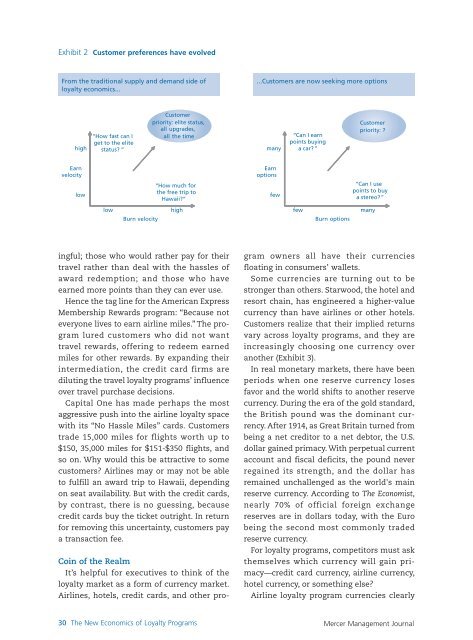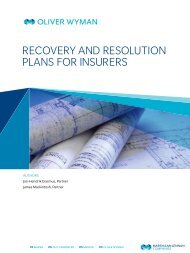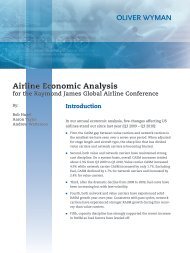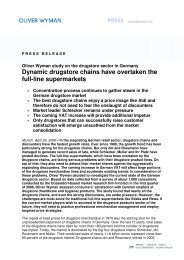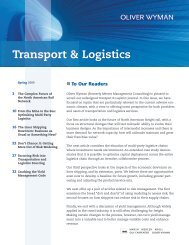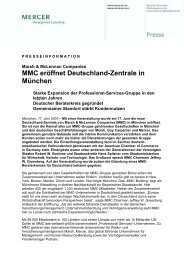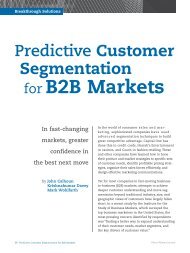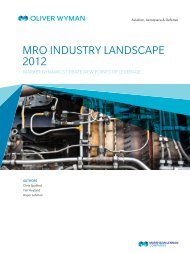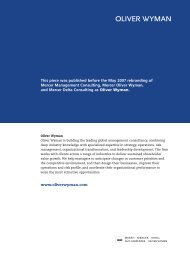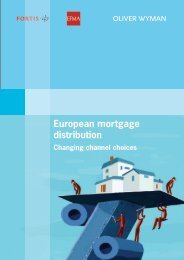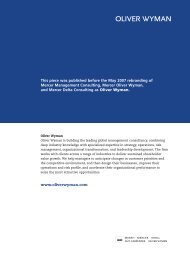The New Economics of Loyalty Programs Customers ... - Oliver Wyman
The New Economics of Loyalty Programs Customers ... - Oliver Wyman
The New Economics of Loyalty Programs Customers ... - Oliver Wyman
You also want an ePaper? Increase the reach of your titles
YUMPU automatically turns print PDFs into web optimized ePapers that Google loves.
Exhibit 2 Customer preferences have evolved<br />
From the traditional supply and demand side <strong>of</strong><br />
loyalty economics...<br />
high<br />
Earn<br />
velocity<br />
low<br />
“How fast can I<br />
get to the elite<br />
status? ”<br />
low<br />
Burn velocity<br />
Customer<br />
priority: elite status,<br />
all upgrades,<br />
all the time<br />
“How much for<br />
the free trip to<br />
Hawaii?”<br />
high<br />
ingful; those who would rather pay for their<br />
travel rather than deal with the hassles <strong>of</strong><br />
award redemption; and those who have<br />
earned more points than they can ever use.<br />
Hence the tag line for the American Express<br />
Membership Rewards program: “Because not<br />
everyone lives to earn airline miles.” <strong>The</strong> program<br />
lured customers who did not want<br />
travel rewards, <strong>of</strong>fering to redeem earned<br />
miles for other rewards. By expanding their<br />
intermediation, the credit card firms are<br />
diluting the travel loyalty programs’ influence<br />
over travel purchase decisions.<br />
Capital One has made perhaps the most<br />
aggressive push into the airline loyalty space<br />
with its “No Hassle Miles” cards. <strong>Customers</strong><br />
trade 15,000 miles for flights worth up to<br />
$150, 35,000 miles for $151-$350 flights, and<br />
so on. Why would this be attractive to some<br />
customers? Airlines may or may not be able<br />
to fulfill an award trip to Hawaii, depending<br />
on seat availability. But with the credit cards,<br />
by contrast, there is no guessing, because<br />
credit cards buy the ticket outright. In return<br />
for removing this uncertainty, customers pay<br />
a transaction fee.<br />
Coin <strong>of</strong> the Realm<br />
It’s helpful for executives to think <strong>of</strong> the<br />
loyalty market as a form <strong>of</strong> currency market.<br />
Airlines, hotels, credit cards, and other pro-<br />
30 <strong>The</strong> <strong>New</strong> <strong>Economics</strong> <strong>of</strong> <strong>Loyalty</strong> <strong>Programs</strong><br />
...<strong>Customers</strong> are now seeking more options<br />
many<br />
Earn<br />
options<br />
few<br />
“Can I earn<br />
points buying<br />
a car?”<br />
few<br />
Burn options<br />
Customer<br />
priority: ?<br />
“Can I use<br />
points to buy<br />
a stereo?”<br />
many<br />
gram owners all have their currencies<br />
floating in consumers’ wallets.<br />
Some currencies are turning out to be<br />
stronger than others. Starwood, the hotel and<br />
resort chain, has engineered a higher-value<br />
currency than have airlines or other hotels.<br />
<strong>Customers</strong> realize that their implied returns<br />
vary across loyalty programs, and they are<br />
increasingly choosing one currency over<br />
another (Exhibit 3).<br />
In real monetary markets, there have been<br />
periods when one reserve currency loses<br />
favor and the world shifts to another reserve<br />
currency. During the era <strong>of</strong> the gold standard,<br />
the British pound was the dominant currency.<br />
After 1914, as Great Britain turned from<br />
being a net creditor to a net debtor, the U.S.<br />
dollar gained primacy. With perpetual current<br />
account and fiscal deficits, the pound never<br />
regained its strength, and the dollar has<br />
remained unchallenged as the world's main<br />
reserve currency. According to <strong>The</strong> Economist,<br />
nearly 70% <strong>of</strong> <strong>of</strong>ficial foreign exchange<br />
reserves are in dollars today, with the Euro<br />
being the second most commonly traded<br />
reserve currency.<br />
For loyalty programs, competitors must ask<br />
themselves which currency will gain primacy—credit<br />
card currency, airline currency,<br />
hotel currency, or something else?<br />
Airline loyalty program currencies clearly<br />
Mercer Management Journal


